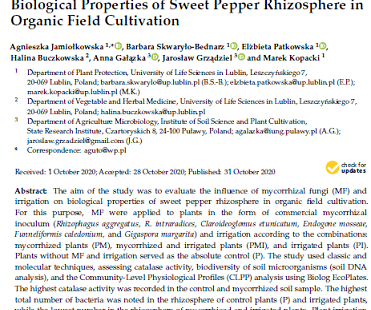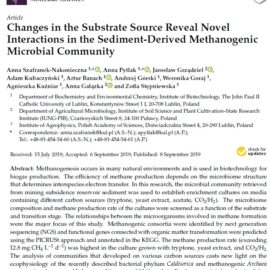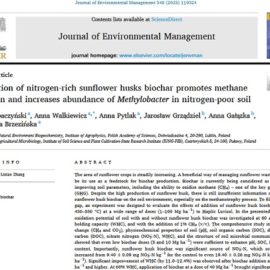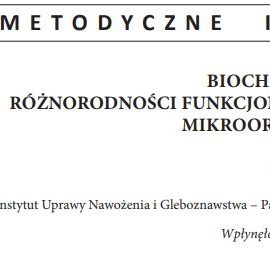Jamiołkowska A., Skwaryło-Bednarz B., Patkowska E., Buczkowska H., Gałązka A., Grządziel J., Kopacki M. (2020): Effect of Mycorrhizal Inoculation and Irrigation on Biological Properties of Sweet Pepper Rhizosphere in Organic Field Cultivation. Agronomy, 10, 1693 (100 pkt. MNiSW; IF = 2.603)
DOI: https://www.mdpi.com/2073-4395/10/11/1693
Abstract
The aim of the study was to evaluate the influence of mycorrhizal fungi (MF) and irrigation on biological properties of sweet pepper rhizosphere in organic field cultivation. For this purpose, MF were applied to plants in the form of commercial mycorrhizal inoculum (Rhizophagus aggregatus, R. intraradices, Claroideoglomus etunicatum, Endogone mosseae, Funneliformis caledonium, and Gigaspora margarita) and irrigation according to the combinations: mycorrhized plants (PM), mycorrhized and irrigated plants (PMI), and irrigated plants (PI). Plants without MF and irrigation served as the absolute control (P). The study used classic and molecular techniques, assessing catalase activity, biodiversity of soil microorganisms (soil DNA analysis), and the Community-Level Physiological Profiles (CLPP) analysis using Biolog EcoPlates. The highest catalase activity was recorded in the control and mycorrhized soil sample. The highest total number of bacteria was noted in the rhizosphere of control plants (P) and irrigated plants, while the lowest number in the rhizosphere of mycorrhized and irrigated plants. Plant irrigation contributed to the increase in the total number of fungi in the rhizosphere. The rhizospheric soil of PM and PMI were characterized by the highest utilization of amines, amides, and amino acids, whereas the lowest level of utilization was detected in the P and PI rhizospheres. The highest biodiversity and metabolic activity were observed in the rhizospheres from the PMI and PM samples, whereas lower catabolic activity were recorded in the P and PI rhizospheres. The mycorrhization of crops improved the biological properties of the rhizosphere, especially under conditions of drought stress.



